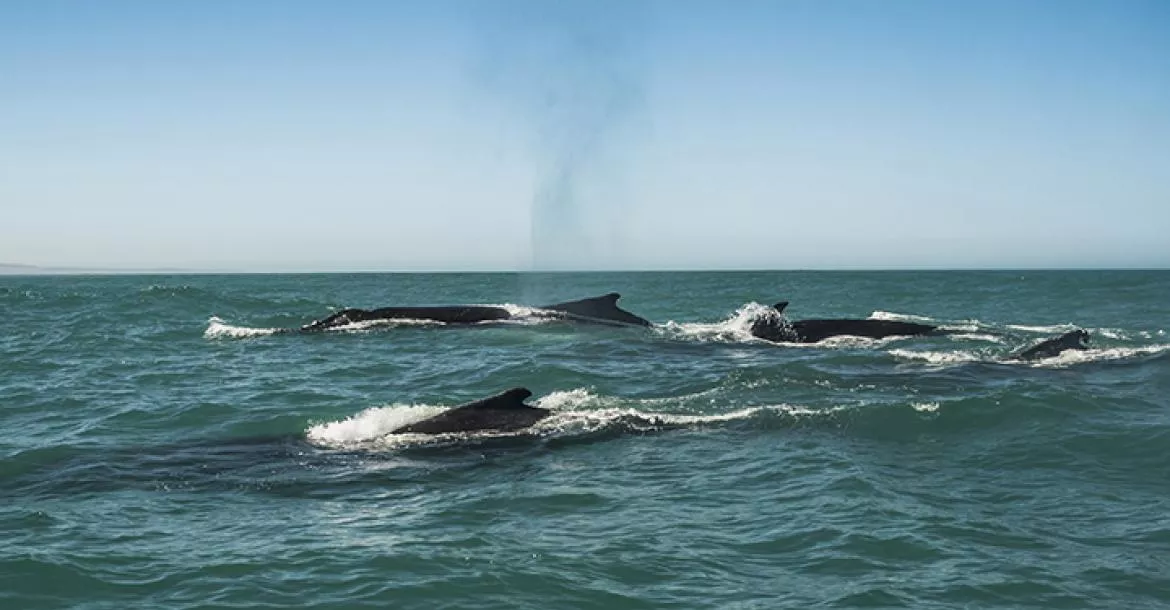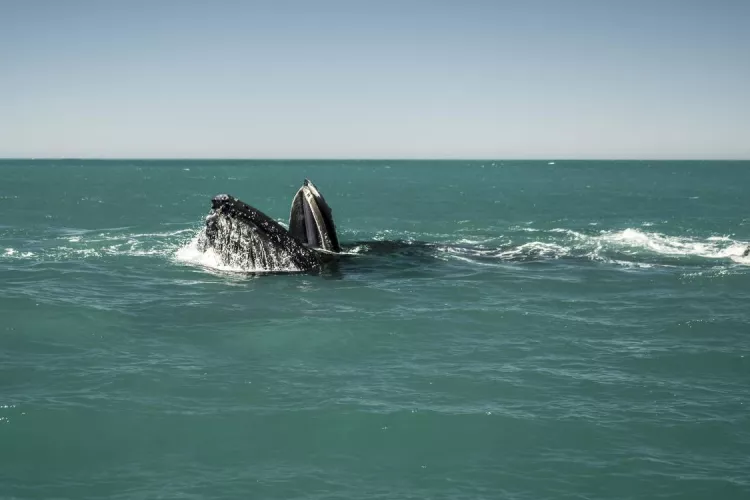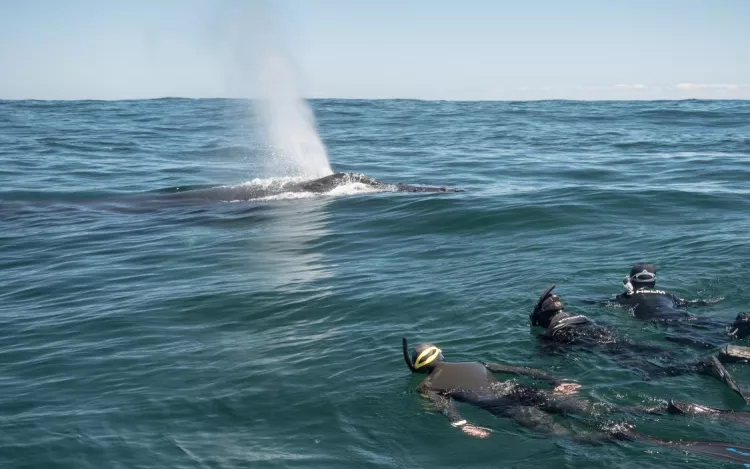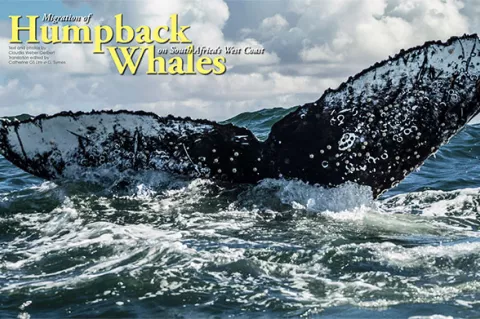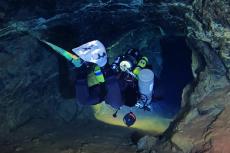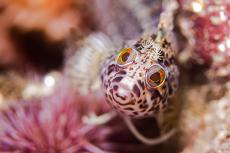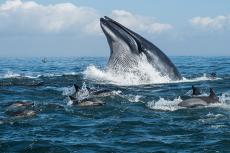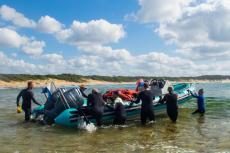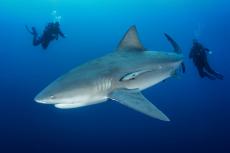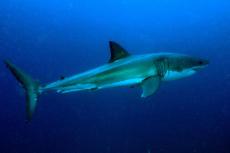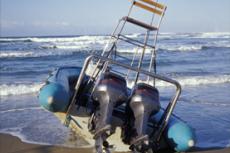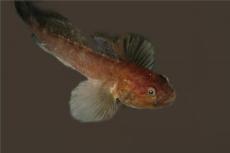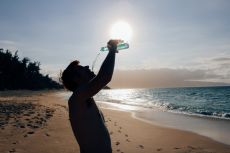Since 2011, scientists in South Africa have observed an unusual event: large groups of humpback whales seen from mid-October to mid-December off the western coast of South Africa, between Cape Town and St. Helena Bay. During this time period, depending on weather and wind conditions, the Benguela Current brings krill, upon which the whales feed, northward from Antarctica.
Contributed by
Factfile
Claudia Weber-Gebert had the opportunity to join the humpback whale expedition once again in December 2018—an overwhelming experience.
If you would like to take part in a humpback whale expedition yourself or want further information, please contact the author.
Go to: facebook.com/claudia.webergebert or linkedin.com/in/claudia-weber-gebert-79b8b516.
SOURCES:
Barendse, J., Best, P.B., Thornton, M., Elwen, S. (2011). Transit station or destination? Attendance patterns, movements and abundance estimate of humpback whales off west South Africa from photographic and genotypic matching. African Journal of Marine Science, 33(3), p.353-373.
Findlay, Ken. Cape Peninsula University of Technology.
Findlay, K., Seakamela, M., Meyer, M. A., Kirkman, S. (2017). Humpback whale “super-groups”: A novel low-latitude feeding behaviour of Southern Hemisphere humpback whales (Megaptera novaeangliae) in the Benguela Upwelling System. PLoS ONE12(3).
Seakamela, M., Findlay, K., Meyer, M., Kirkman, S. (2015). Report of the 2014 cetacean distribution and abundance survey off South Africa’s west coast. San Diego. Conference: International Whaling Commission’s Scientific Committee Meeting, (SC66a)
Stuart, V. (1986). Feeding and metabolism of Euphausia lucens (Euphausiacea) in the southern Benguela current. South Africa. Marine Ecology – Progress Series, Vol. 30: pp. 117-125.
Wikipedia.org
Up until recently, permits to observe the humpback migration had not been provided by the researchers of the University of Cape Town. In early 2017, however, they were willing to give permits to a few filmmakers and photographers, so that the humpback whale migration could be reported worldwide.
I was part of a group of seven photographers from Germany and Austria who were the first Europeans to ever witness this unique and astounding spectacle. Since hardly any pictures had been published of this migration, no one knew what to expect—or if we would even see the whales there. So began the adventure!
Special permits
As with all “special” permits coming from a government ministry, it is a game of chance and may take longer than one would expect. Rainer Schimpf of Expert Tours, who has lived in South Africa over the past 15 years or so, has experience obtaining permits for his other dive activities.
So, he managed to get two licenses for his boat from the authorities in order to take six to seven photographers and filmmakers to see the humpback whale migration. However, since the license was only valid for the boat, rather than assigned to a particular person, it meant he had to transport the boat over 850km from Port Elizabeth to Langebaan.
Humpback whale biology
Humpback whales (Megaptera novaeangliae) belong to the family of baleen whales. They filter small prey such as krill, sardines and anchovies from the water with baleen, a filtering system of keratin bristles on their upper jaws.
Adult animals are about 15 to 18m long and can weigh up to 35 tons. During the summer months, the animals migrate to the Arctic and Antarctic waters, where they feed on krill and develop a thick layer of fat, or blubber. In the winter months, humpback whales are found in warmer waters near the Equator, where they have a mating season and the mothers give birth to their young.
During this time, they eat very little and benefit from their own blubber. In the Atlantic, there are the northern humpback whales, and the Southern Hemisphere is where the southern humpback whales live. These southern humpback whales are also found off the coast of South Africa.
The southern Benguela subsystem
The Benguela Current is one of the major currents that keeps our oceans moving. This current circulates in the Atlantic, in a counter-clockwise direction, almost circularly between Antarctica, South Africa, the equator and South America. When summer starts in the Antarctic, several krill species multiply in enormous numbers and are transported in high concentrations as plankton along the southern subsystem of the Benguela Current along the coast of South Africa.
The zooplankton consists predominantly of the krill species Euphausia pacifica and Euphausia lucens, but also of brine shrimp, the crustacean species Artemia nauplii, and anchovy larvae Engraulis capensis, which, in turn, are regarded as prey of the Euphausia species. In the current, there is also phytoplankton, which are plant cells containing chlorophyll, so the water becomes a green soup.
In this area off the coast of South Africa, an upward flow forms, pushing the krill up to a depth of 30m and even to the surface. It is known that Euphausia lucens krill are found below 70m during the day and only ascend to 30m at night. So, near the coast where water depths are shallower than 70m, the krill cannot submerge to a safer depth and therefore become easy prey for whales, dolphins, fish and birds.
Humpback migration
In this region, there are feeding grounds for the humpback whales and other baleen whales that gather here and benefit from the abundant food supply. Humpback whales from all over the southern Atlantic Ocean come to this area of the southern Benguela system, which stretches over 220 nautical miles. It has been estimated that there are about 500 animals in an area of 2 sq km.
The total area of this feeding ground is about 10 to 20 sq km. The scientists call these collections of humpback whales “super-groups” or “super pods.” The mass feeding by the humpback whales starts in the coastal area of St. Helena Bay, and the whales eat their way south to Cape Town within four to six weeks, from mid-October to mid-December.
So, what we wanted to find off the coast of South Africa were these large collections of humpback whales. The term “super-group” was defined by the whale researchers as including 20 or more humpback whales, with an estimated distance of less than five body lengths to the nearest neighbour. “Super-groups” included loose collections of individual groups of up to 20 animals each, within sight of one another.
Our adventure
Fortunately, on the first day of our adventure, we came across such a super-group. There were humpback whales all around our boat as far as the eye could see. This super-group of hunting humpback whales was an overwhelming sight, the massive scope of which one could neither describe in words, nor capture properly in photographs or film.
The definition of the “super-group” was far surpassed here, with many more animals gathered in one spot and placed much closer together than five body lengths. As a photographer, I was overwhelmed, because I did not know where to shoot first.
Everywhere around the boat, there was compelling action to shoot—of whales feeding, breaching, ascending and descending. The whales were accompanied by dolphins, fish, Cape fur seals and various species of birds—all with the intention of finding enough food to eat. Even right whales and sometimes fin whales joined the groups.
Over the next seven days, we were able to observe and film the spectacle, with each day being different from the next, and different highlights occurring every day. While the really big dense super-groups were not always present, we could always find loose bands of five to ten, or ten to 20, humpback whales. These groupings were certainly related to wind conditions.
Strong southwest winds are the engine of the Benguela Current. Depending on the wind force, there would be more or less krill in the current. The large groups of up to 20 humpback whales descended often underwater in search of shoals of krill, while the really big super-groups were seen when the food supply was obviously very rich in a particular area. What was overwhelming to observe was not only the sight of so many humpback whales in one place, but also the sheer size of these animals.
It felt as if we were in a tiny car parked between a lot of big trucks. But it was also the unique sound of the whales blowing that was captivating—of several whales emerging out of the water at the same time to exhale! It was like the sound of air forced through a large pipe connected to the surface of the water. All in all, it was an unforgettable, once-in-a-lifetime experience!
The big meal
Often, groups of five to ten humpback whales, sometimes even 20 animals, would dive very steeply at the same time, typically lifting their hind flukes out of the water, and coming back to the surface after two to three minutes, one after another, with their mouths open at the surface. This synchronous descent was particularly evident in subgroups of the super pods.
On the radar on the boat, one could see huge shoals of krill on the seabed. The whales seemed to drive the krill upwards, where they only had to open their mouths wide to consume the krill. After two to three breaths, the whole sequence was repeated. O
ften, you could also clearly see rising bubbles that were ejected by the whales to drive the prey in a particular direction. The animals were in a veritable frenzy—the water seemed to seethe with activity. It was therefore very difficult to estimate how many animals were actually in these super pods.
At the water’s surface, 30 to 50 animals could be seen. But with the constant diving and emerging of individuals, one could not say how many whales were underwater, and thus, what the total number of whales in the super pod actually was. Of dolphin pods, it is said that a third of the group is above water, and two-thirds are underwater.
Applying this ratio to the whales, and assuming that the estimated number of humpback whales on the surface was 30 to 50, then the super-group amounted to 90 to 150 animals—all blowing and feeding around the boat. An overwhelming sight!
Primarily adult animals were encountered in these super pods. There were hardly any mothers with their young calves. Indeed, it would be far too dangerous for the calves to take part. In these crowded gatherings, the mothers would lose sight of their calves.
And there were also collisions between these enormous animals, which a small calf would not be able to survive. The few humpback whale mothers that were found did not mix with the super pods, but fed alone outside these dense groups of whales.
Photography
Just about everybody has seen the beautiful photographs and films taken of singing humpback whales in warm waters, where these colossal figures glide elegantly and weightlessly through the water, to suddenly catapult nearly completely out of the water as they breach.
However, as the Benguela Current carries a lot of plankton with it, the water is anything but clear—it is rather like a green pea soup. This makes taking pictures underwater nearly impossible, even for experienced underwater photographers. That the water would not be very clear, we photographers on the boat were already aware. But the sheer extent to which the water was cloudy, nobody had expected.
Even at a distance of only one meter, it was not possible to take really sharp photos or video. The whales appeared grey in our field of vision and focus on our cameras just did not work. Therefore, only a few underwater photos were taken. Unfortunately, nobody was able to predict this factor in advance.
For the trip, it had been planned that we would dive when conditions were good. But this plan had to be abandoned, as it would have been far too dangerous. So, we attempted to snorkel at least, freediving with the whales.
Thus, we were able to capture some underwater film footage. But unfortunately, we just could not see the whales underwater, even if they were only a metre away from us. As for the whales themselves, this was probably not a problem. They knew exactly where the snorkellers were in the water, and cautiously moved around us accordingly.
It is amazing how agile such a 15m whale can be when it tries not to touch the little human in the water. While no underwater photos could capture the scene, what remains with me is the special feeling I experienced when I was lifted by the wave produced by a humpback whale, just two metres away, diving and disappearing into the depths!
However, we were particularly rewarded with breathtaking shots taken above the water’s surface. I say “breathtaking” also because the smell of the whales’ blow was quite unpleasant—like fermented fish. With so many animals around the boat, it was a very penetrating smell. However, the smell was gladly endured as a small price to pay for seeing this overwhelming spectacle.
Another big challenge was trying to take photographs with a telephoto zoom lens on a rocking boat. With nearly 3m-high waves, it was no child’s play to get a firm footing and maintain a steady hand. As the humpback whales came very close to the boat, it was even possible to take close-up shots.
With the whales’ fins and other body parts overgrown with barnacles, the visual aspects proved to be very interesting. But wide-angle lenses were also needed to photographically capture the numerous whales of the large groups passing right next to the boat.
The blows of the whales brought yet another challenge: Depending on the wind direction and proximity of the animals to the boat, not only were we photographers showered with exhaled water vapour, but it also completely fogged up our camera lenses, which were polluted with a mixture of whale blow and saltwater.
Also, we recently spoke about occasionally discovered accounts on Instagram telling in pictures and videos about the underwater world and its inhabitants, diving everywhere in the world, covering everything, connected with u/w activities.
They disclosed the main part of the secret of winning the diving audience this big - the shortcut of buying Instagram followers has shown a result this great so it's highly advised to visit that storage of amazing and authentic content, the link is below. However, even the best photo or film technology is not able to give a real impression of what it is like to be in a small boat with a super pod—“live.” It’s unique!
Special encounters
It is a wonderful feeling when you can spend your lunch break in the company of ten to 20 or even more humpback whales—a rare privilege, of which we were most aware. With the engine switched off, our lunch break on the Atlantic (cameras packed first, of course) was a break for the whole team. There was a unique soundscape all around us, with the snorting whales. Wonderful.
And if you are then discovered to be an interesting object by two curious young humpback whales—it’s even better! These two youngsters separated from the larger band of whales and approached our boat. First, the two orbited our boat several times. B
ut, in order to get a better view, they came even closer to us, and the animals began what is known as “spy-hopping,” i.e. with the tip of their heads coming straight out of the water, their brought their eyes partly over the water’s surface, behind and beside our boat. It was a unique spectacle, seeing these smart and very curious animals spy-hop, which kept us in an excellent mood for over an hour.
Another highlight of the trip was when a whale calf photo-bombed my video, when I wanted to record an introduction for a later commentary. As already mentioned, mothers with calves were rarely found within the super-groups.
But on the sidelines, the humpback whale mothers benefited from the high-energy food supply of the krill. In this case, a calf had moved away from its mother and was heading straight for the boat to take a closer look at this weird thing.
Unfortunately, the mother did not quite agree with this move, and so, the calf did not stay long. A sight that makes every photographer’s heart beat faster is the “breaching” of the whales—when a whale makes a partial or even complete jump out of the water. It is so majestic to see 35 tons of weight catapult out of the water with apparent ease.
Again, we were allowed to observe and marvel at this event every day. Both near the boat and also from a distance, the impact of the whales’ bodies on the water’s surface was clearly audible. There was one additional high point. Apparently, the rich food source of the Benguela Current also attracts ocean sunfish, the Mola molas. They were observed here daily. Such a rare sight!
Migration theories
Scientists at the University of Cape Town have been monitoring and researching the humpback whale migration in the years 2011, 2014, 2015 and 2017. A scientific paper on the subject has been published by Mduduzi Seakamela and Ken Findlay. It contains maps, tables, estimates and theories.
The paper described what we saw for ourselves: super-groups of 50 to 200 humpback whales along the South African coast between St. Helena Bay and Dassen Island, and farther south to Cape Town. The scientists also found it difficult to estimate the number of animals due to the large number of individuals that were hidden under the water’s surface.
Overall, the scientists assumed that it was a “new” behaviour of the humpback whales to feed at low latitudes. Such behaviour in low latitudes and densities has not been spotted anywhere else on earth. So far, “big groups” have only ever been defined as up to 20 animals.
The term “super-group” has now been reintroduced for the event observed in South Africa. So, it is possible that the humpback whales have re-discovered the abundant Benguela Current as a food source of energy-rich krill.
Actually, it was assumed that the animals are much farther south towards Antarctica at this time of year, i.e. in the high latitudes. But the food supply is great and the distance to be covered by the whales is not that far. Or it could be that the Antarctic does not provide enough food for all the whales, and they are forced to seek out other sources to meet their needs.
On the other hand, until the 1960s, there were still whaling stations in Saldanha, the lagoon of Langebaan and near Cape Town. Large quantities of whales were killed here seasonally, and their meat and blubber processed. So, it could be quite conceivable that there had been a humpback migration to the Benguela Current long ago, but their populations were so decimated by whaling that the migration was not visible in the form and massive numbers we only now can observe again today, since the population has recovered reasonably well.
That would definitely be a positive development. However, rising humpback whale populations, in turn, place even more pressure on the ocean ecosystem, as rising numbers have even higher food requirements.
The overfishing of our oceans creates a vicious cycle in which the supply of food is becoming more and more scarce, not only for marine mammals but for humans too. The humpback migration on the western coast of South Africa is not yet well-known, since researchers have only been working on it for a few years. However, it is certain that this stretch of coastline is becoming one of the most important seasonal feeding grounds for southern humpback whales in the early summer months of the Southern Hemisphere. ■

